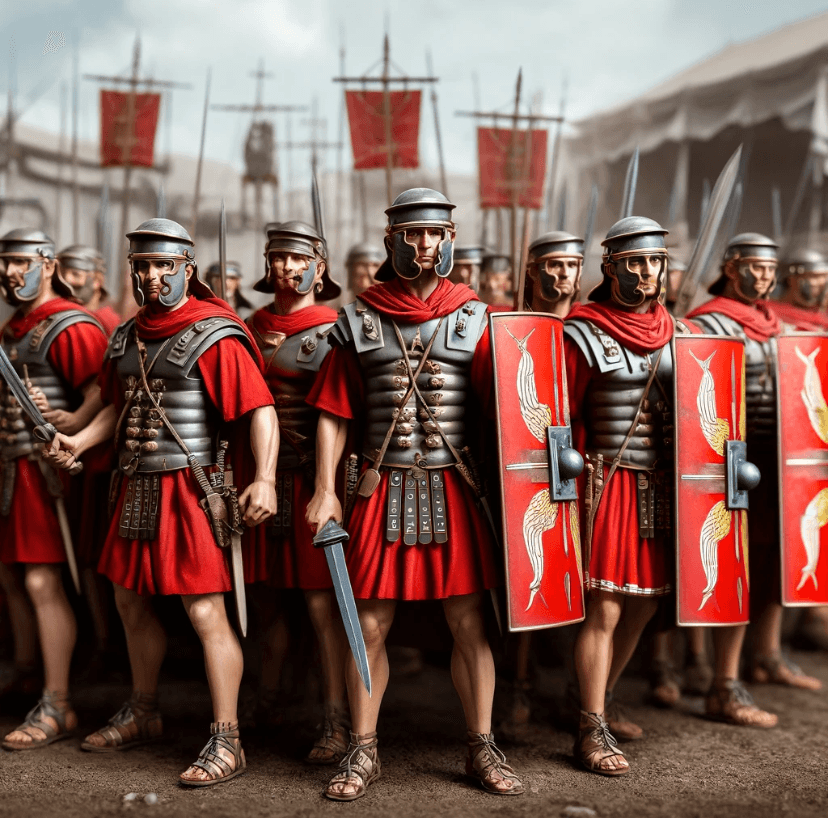Why Did Roman Soldiers Wear Red Tunic?

Roman fabrics were mostly woven from two main components. These were wool and linen. Wool was made from the fur of animals such as sheep and goats. The goats and sheep used to make wool were raised in Italy, as well as in Greece, Spain, and many other parts of Europe. Wool was defined by its natural color as well as its quality. For example, wool from parts of northern Italy was noted for its feather-like shine and feel. The second main material used in Roman textiles was linen. Linen is a fabric made from flax plants and was widely used by the ancient Egyptians. As Roman civilization flourished, linen was produced in Egypt, Syria, and Palestine, and to a lesser extent in Europe. This soft, light and breathable material was perfect for adapting to life in the hot and humid Mediterranean.
Linen and wool were the main components of Roman textiles and were often woven together. However, there were other materials that made their way into Rome. Cotton from India and North Africa was imported into the Italian Peninsula. The Romans also took a liking to silk. Yes, silk. We tend to forget this, but the first major Silk Roads between China and Europe existed since the first century BC. These silks were extremely expensive and very valuable goods due to their intensive imported processes. It's worth noting that there is also an indigenous moth on the Mediterranean island of Kos that can be used to make cocoons silk, but Coan Silk, as it's called, has never been considered as high-quality as the Chinese version. It should also be noted that silk was a material considered suitable only for women' clothing; Men were not allowed to wear it.
These raw materials were the basic fabrics used by the Romans, but let's not forget how fashion-conscious the Romans were. They would not leave their cloth unadorned. The last major components we should mention are the dyes. The Romans dyed their fabrics with materials imported from the Mediterranean. From roots to minerals, insects and rare shellfish, the Romans filled their fabrics with an incredible range of colors, from earthy hues of red and orange to vibrant greens, purples and blues.
From Rome's earliest days, a wide variety of colours and coloured fabrics would have been available; in Roman tradition, the first association of professional dyers dated back to the days of Kiing Numa. Roman dyers would certainly have had access to the same locally produced, usually plant-based dyes as their neighbours on the Italian pennisula, producing various shades of red, yellow, blue, green, and brown; blacks could be achieved using iron salts and oak gall. Other dyes, or dyed cloths, could have been obtained by trade, or through experimentation. For the very few who could afford it, cloth-of-gold was almost certainly available, possibly as early as the 7th century BC.
Throughout the Regal, Republican, and Imperial eras, the fastest, most expensive and sought-after dye was imported Tyrian purple, obtained from the murex. Its hues varied according to processing, the most desirable being a dark "dried-blood" red.Purple had long-standing associations with regality, and with the divine. It was thought to sanctify and protect those who wore it, and was officially reserved for the border of the toga praetexta, and for the solid purple toga picta. Edicts against its wider, more casual use were not particularly successful; it was also used by wealthy women and, somewhat more disreputably, by some men. Verres is reported as wearing a purple pallium at all-night parties, not long before his trial, disgrace and exile for corruption. For those who could not afford genuine Tyrian purple, counterfeits were available.The expansion of trade networks during the early Imperial era brought the dark blue of Indian indigo to Rome; though desirable and costly in itself, it also served as a base for fake Tyrian purple.
For red hues, madder was one of the cheapest dyes available. Saffron yellow was much admired, but costly. It was a deep, bright and fiery yellow-orange, and was associated with purity and constancy. It was used for the flammeum (meaning "flame-coloured"), a veil used by Roman brides and the Flaminica Dialis, who was virgin at marriage and forbidden to divorce.Specific colours were associated with chariot-racing teams and their supporters. The oldest of these were the Reds and the Whites. During the later Imperial era, the Blues and Greens dominated chariot-racing and, up to a point, civil and political life in Rome and Constantinople. Although the teams and their supporters had official recognition, their rivalry sometimes spilled into civil violence and riot, both within and beyond the circus venue.
The most common color for legionnaires' tunics was off-white - that is, undyed and untreated wool. The second most common color was a deep brownish red. The latter was not the result of an expensive dye and was made using dried root dye, one of the cheapest and most common dyes of the time.
On the battlefield, the red tunic worn under the armour represented blood and strength. Certainly, the compact line of the Roman infantry, dressed in red, had a psychological impact on the enemy army, which perceived it as strong and valiant.
Unsurprisingly, red appears as a symbolic colour in many a warrior setting. In Roman mythology, it was associated with blood, of course, and courage. It was the colour of the god of war, Mars – and the colour of the army. Roman soldiers wore red tunics, while gladiators were adorned in red.
